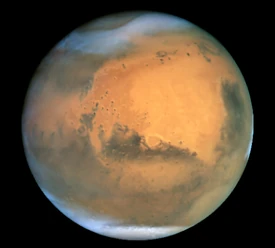| Mars ( Planet ) | |
|---|---|

| |
| Diameter | :4,221 miles |
Mars is the fourth planet from the Sun. The high amounts of Iron in its soil is what gives it a red orange color. This is why it is known as "the red planet". In Roman mythology, Mars was the God of War. All investigations of Mars, either with telescopes or with the space objects sent there to explore it's surface, came to the same result: There is no life on Mars, not even in primitive form (viruses). But, there could be life in the past, maybe a billion years ago, when liquid water flew over it's surface and the atmosphere was much thicker than it is today (about 1% of the pressure on earth). A day on Mars lasts almost the same as on Earth (slightly more than 24h for one full rotation). Two tiny moons are orbiting around the planet, in a very small distance (related to the distance earth-moon) and the most proper scenario is that a large asteroid crashed againsts mars about 4 billion years ago and sent millions of heavy pieces in space. Two of them are still there (called Phobos and Deimos) building this two tiny moons, while the others got lost in our planetary system, with some of them still falling on Earth and the other inner planets.
| |||
|---|---|---|---|
| The Sun · Mercury · Venus · Earth · Mars · Ceres* · Jupiter · Saturn · Uranus · Neptune · Pluto* · Haumea* · Makemake* · Eris* · Dwarf Planet Candidates* | |||
| Planets · Dwarf Planets · Moons: Terran · Martian · Asteroidal
· Jovian · Saturnian · Uranian · Neptunian · Plutonian · Eridian | |||
| 'Ceres * Pluto * Haumea * Makemake * Eris | |||
| Small bodies: Meteoroids · Asteroids (Asteroid belt) · Centaurs · TNOs (Kuiper belt/Scattered disc) · Comets (Oort Cloud) | |||
| Hypothetical Bodies: Vulcan · Planet 9 · Planet 10 · Tyche · Nibiru · Nemesis · more... | |||
| Planets with '*' are dwarf planets. | |||
| See also astronomical objects and the solar system's list of objects, sorted by radius or mass. |